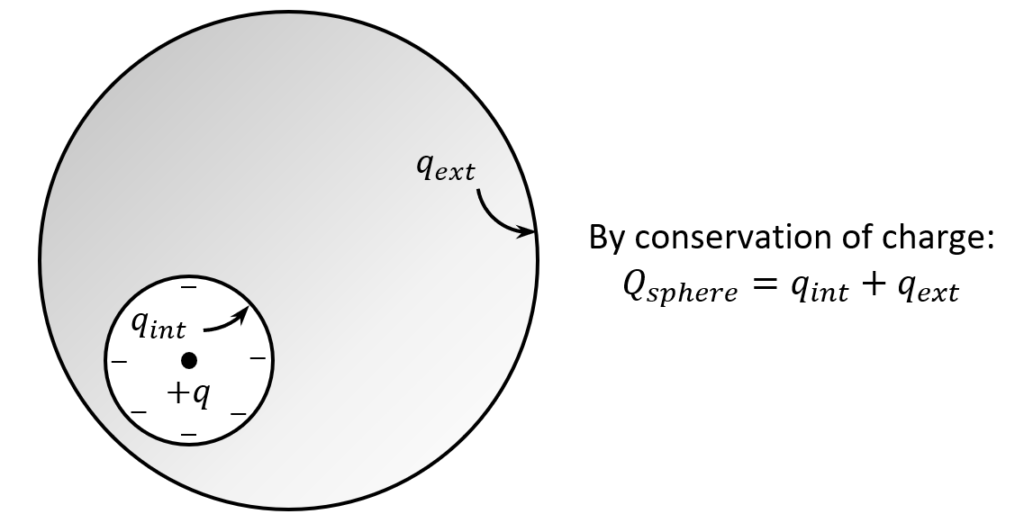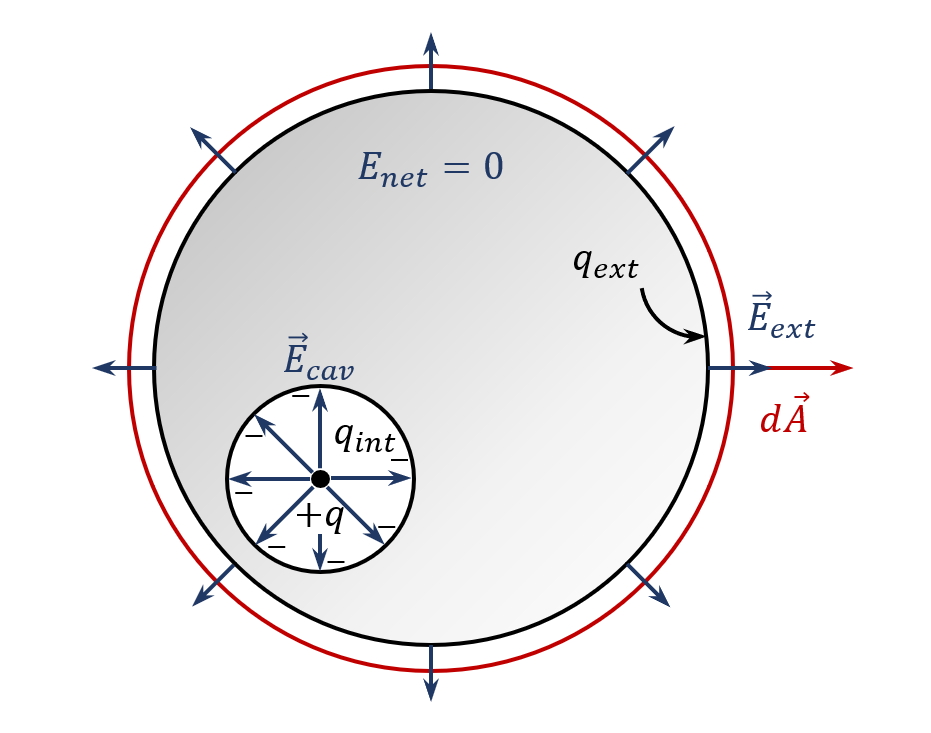P20B2015 – Spherical Off-Center Cavity
Spherical Off-center Cavity
A spherical cavity is hollowed out of the interior of a neutral metallic sphere. At the center of the cavity is a point charge, of positive charge $q$, as shown below.

1. What is the total surface charge $q_{int}$ on the interior surface of the conductor?
View answerThe point charge $+q$ at the center of the cavity attracts the negative charges of the sphere (which are free to move) to the interior surface. To determine the amount of charge $q_{int}$ on the interior surface, we use the fact that the electric field inside conducting material is zero (in electrostatic equilibrium). We apply Gauss’s law and we choose a sphere slightly larger than the cavity, centered on the cavity, as our Gaussian surface.

Within the conducting material (sphere) in electrostatic equilibrium, the electric field is $E=0\ N/C$. Therefore, the electric flux through our Gaussian surface must equal zero and we can then derive the amount of charge $q_{int}$ on the inner surface of the cavity by Gauss’s Law as follows
\begin{aligned}
\oiint{\overrightarrow{E}\cdot d\overrightarrow{A}}=\frac{Q_{enc}}{{\varepsilon }_0}\ \ \ \ \ \ \ &{{\mathop{\Longrightarrow}\limits_{E=0}}}\ \ \ \ \ \ \ 0=\frac{q+q_{int}}{{\varepsilon }_0} \\
\\
&\Rightarrow \ \ \ \ \ \ \ q_{int}=-q
\end{aligned}The total surface $q_{int}$ on the interior surface of the conductor is therefore equal to
\boxed{q_{int}=-q}Note: the point charge $+q$ attracts a charge $-q$ to the inner surface of the cavity. No more, and no less.
2. What is the total surface charge $q_{ext}$ on the exterior surface of the conductor? How is it distributed and why?
View answer
Since the conducting sphere is neutral, we derive that the charge $q_{ext}$ on the outer surface of the conductor must be such that the entire charge of the conducting sphere is zero by conservation of charge. Thus, we write
\begin{aligned}
Q_{sphere}=0\ C \ \ \ \ &\Rightarrow \ \ \ \ \ q_{ext}+q_{int}=0 \\
\\
&\Rightarrow \ \ \ \ \ q_{ext}=-q_{int}=q
\end{aligned}and derive that the total surface charge $q_{ext}$ on the exterior surface of the conductor is equal to
\boxed{q_{ext}=q}3. Express the electric field inside the cavity $\left(E_{cav}\right)$, in the metal sphere $\left(E_{met}\right)$ and outside the conducting sphere $\left(E_{ext}\right)$. Specific the origin of your coordinate system.
View answerThe electric field inside the cavity is the electric field created by the point charge $q$ and its magnitude is equal to
\boxed{E_{cav}=\frac{kq}{r^2}=\frac{q}{4\pi {\varepsilon }_0r^2}}This electric field points outward, radially, from the center of the cavity with $r$ measured with respect to the center of the cavity.
The electric field inside the conductor in electrostatic equilibrium is zero and therefore we have
\boxed{E_{met}=0}To find the electric field outside of the conducting sphere, we choose a spherical Gaussian surface, larger than the sphere and centered on the sphere, and apply Gauss’s Law.

The electric flux through the Gaussian surface is equal to
\oiint_{sphere}{\overrightarrow{E}_{ext}\cdot d\overrightarrow{A}}=\oiint_{sphere}{E_{ext}{\mathrm{cos} \left(0\right)\ }dA}=E_{ext}\cdot 4\pi r^2The charge enclosed by the Gaussian surface is equal to the charge $+q$ of the point charge (and that’s it because the metal sphere is neutral).
Q_{enc}=Q_{sphere}+q=qBy Gauss’s Law, we derive that
E_{ext}\cdot 4\pi r^2=\frac{q}{{\varepsilon }_0}\ \ \ \ \Rightarrow \ \ \ \ \ E_{ext}=\frac{q}{4\pi {\varepsilon }_0r^2}The electric field outside the conducting sphere is therefore given by
\boxed{E_{ext}=\frac{q}{4\pi {\varepsilon }_0r^2}}This electric field point outward, radially, with $r$ measured from the center of the sphere.
